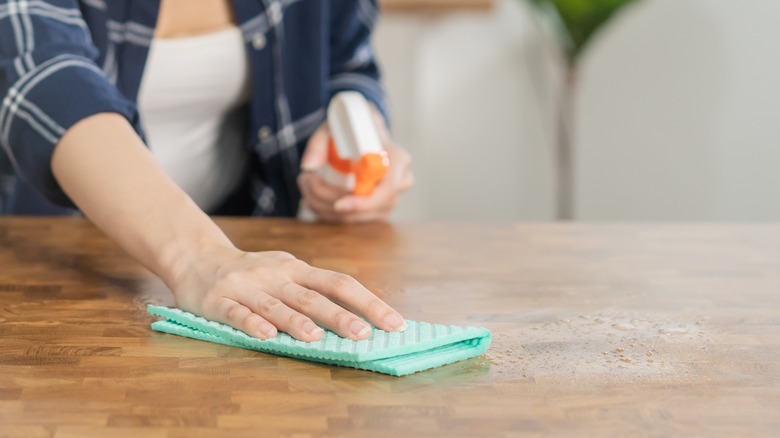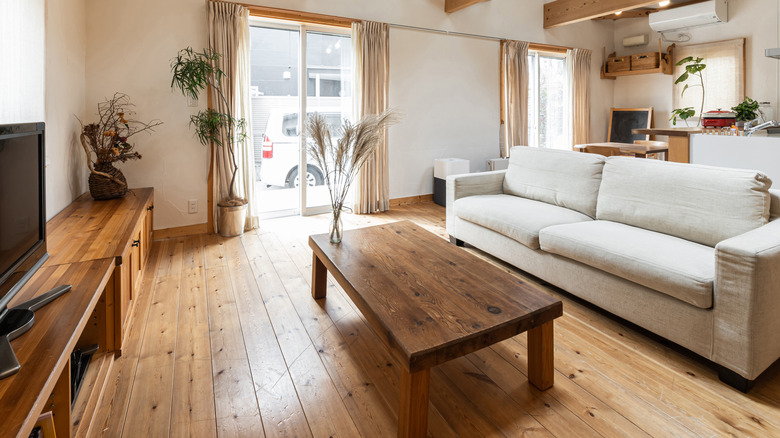Polishing Your Wood Furniture May Be Doing More Harm Than Good
The United States is the second-largest producer of wood in the world and the biggest producer of hardwoods like maple, walnut, oak, and cherry. Of course, softwoods like pine and cedar are also significant exports, but these are most often used in construction, while hardwoods are prized for making high-quality furniture. If you're lucky enough to have genuine wood furniture in your home, you know how these pieces can stand the test of time. However, if you notice your favorite pieces gathering dust and becoming harder to clean, you should reconsider next time you reach for the furniture polish bottle.
Whether your furniture was made in the United States or exported from overseas, it deserves a particular care routine to keep it looking fresh and luminous. Part of your regular home maintenance should include dusting and polishing, but wood furniture lovers should proceed with caution here. All too often, we slap a rag and polish spray on our favorite pieces and call it a day, but that habit might actually be damaging your furniture and making it trickier to keep clean. This is because many mainstream polishes include ingredients that can trap or attract dust. Following a less-than-ideal routine cleaning might even exacerbate the irksome result of using too much polish.
Over-polishing creates sticky surfaces
Ideally, you should dust your wood furniture at least once weekly, or more often if your home is prone to dust and pet dander buildup. However, you shouldn't spray wood furniture with a polishing cleaner whenever you dust. It simply isn't necessary, and over-polishing can cause more problems over time. There's a threefold reason for this.
When you first spray and wipe the furniture with polish, it may seem shiny and clean. You can clearly see where your rag has supposedly wiped, leaving a visible trail in the dust. However, the spray isn't helping you remove all the dust. In fact, a significant amount will be sealed under the spray where your cloth can't reach it. Once there, the dust absorbs polish and forms a sticky layer that makes it harder and harder to clean the furniture every time. Second, furniture polish made with petroleum distillates can even "attract" more dirt and dust. This is because petroleum distillates break down airborne dirt and oil and make them adhere to the surface of furniture. Finally, the motion of wiping with a cloth on top of the polish generates static electricity, magnetically pulling in even more dust.
How to properly dust and polish
If it only makes things worse, should you avoid using polish altogether? Of course not. Occasionally polishing your furniture is important, but overdoing it should be avoided. To keep your wood furniture looking clean, invest in microfiber cloths or a microfiber duster. Because microfiber has a fine knit, it is better for trapping and holding dust than a rough rag, and it won't create tiny scratches on the surface of your furniture. Stick to a weekly dusting routine to keep dust from collecting and compounding in your home.
Remember that a bit of polish can go a long way when polishing your wood furniture. Thoroughly dust your furniture before applying the polish with a microfiber cleaning cloth rather than spraying it directly onto the wood. In general, you should only polish your furniture about once per month, or after every 4-5 dustings if you dust once per week. Use a furniture polish that contains carnauba wax, like Pledge, to form a protective layer over the clean wood and keep airborne dust from settling. Ingredients like dimethicone or silicone oil are also great for nourishing the wood and creating a healthy, shining moisture barrier.


